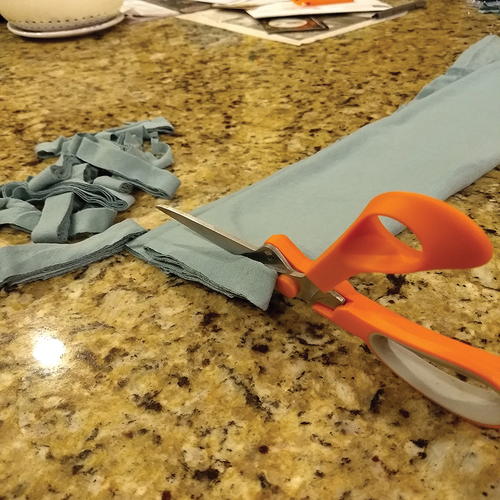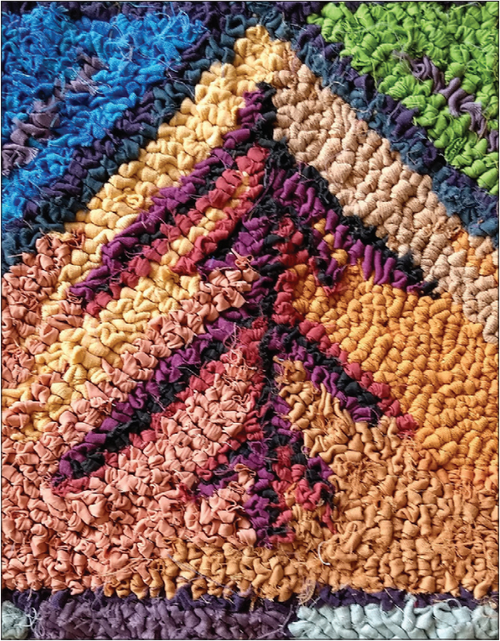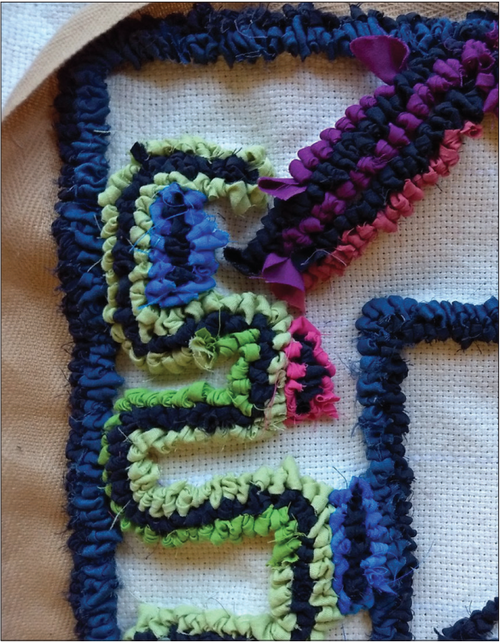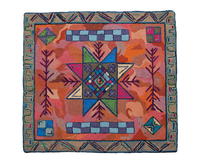You Hook Rugs with Bedsheets?
Why Not? in the Grand Tradition of Rug Hooking, Use What You Have
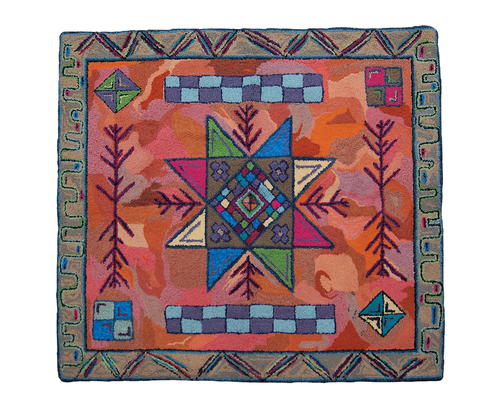
Big Boucherouite, 47" x 53", hand-cut recycled bedsheets and T-shirts on monk’s cloth. Designed and hooked by Laura Salamy, Albuquerque, New Mexico, 2019. GARY LAMOTT
Being mostly self-taught, with little access to wool or cutters or knowledge of such things early in my hooking career, I turned to yarn. This led to Amy Oxford and her punch needles, but that’s a story for another day.
Initially, as I searched for fibers to hook with, I was unaware that there was such a thing as rug yarn! A
neighborhood yarn store sold a nice wool yarn for what I perceived was a fair price. Most importantly, it came in a good number of colors. The two rugs I hooked with it, both floor mats, took a LONG time. Life improved considerably when I discovered Halcyon Yarn in Maine and their rug yarn (I think because I was finally subscribing to Rug Hooking magazine by then). Rug yarn sped up the process immeasurably. And there were all those color choices!
But one gets bored. Wool yarn is beautiful, and it makes a fine rug. Yet they all looked kind of the same after a while.
One day a light bulb came on. A big, old Savers store—think thrift store on steroids—opened in nearby Woonsocket, Rhode Island. I headed that way. Lo and behold, there were wool skirts and blazers! I did what many have done and still do: I deconstructed. I cut the fabric by hand. Voilà! Wool strips. That is when I learned about less-than-ideal wool. But it was all good, until it wasn’t. I was bored again, and there just wasn’t that much good used wool clothing coming into my Savers.
Again, another light bulb: Why are rug hookers limited to just wool? This was probably 12 or 13 years ago. Having no guild group, no hooker friends to sway me, and a limited pocketbook, I quickly moved from a wishful ogler of online wool products to a purveyor of used T-shirts.
Head into any self-respecting thrift store and you’ll find racks and racks of no-longer-loved t-shirts, in all kinds of colors. From there it was just a hop, skip, and a jump to previously owned silk blouses and scarves, ribbon, jeans, and knit bedsheets, which are just giant T-shirts for an even better price.
So many rugs, some all T-shirt, others “mixed fiber.” And all cut with a cheap pair of Fiskars scissors. (These days I have a spring-assisted pair.)
I moved in 2015 to Albuquerque, where there are two Savers stores. Woohoo! As I perused the home goods section for knit sheets one afternoon, another lightbulb went off: Woven bedsheets. Why not?
And an obsession was born. I loved the look, the texture with its little hair-like threads, of a good bedsheet rug. And bedsheets come in all kinds of colors and patterns. Not only that, once your friends (and other people you don’t even know) hear that you’ll recycle their old sheets and clothing, they happily make them available to you. Enough so that you might have to have your husband build you some shelving for your ever-growing stash.
I’ve done several bedsheet rugs in the form of floor mats and table runners/wall-hangings, but one has attracted more attention than others. Big Boucherouite was finished in early 2019, in time for the big, biennial Fiber Arts Fiesta put on by the Albuquerque Fiber Arts Council. At over four feet long, it’s the largest rug I’ve ever hooked.
Boucherouites are rugs woven by Moroccans since the mid-twentieth century. Traditionally, they’re made using old clothes and other textiles. (Recognize a theme here?) Few have actual planned designs but in many ways look as if the weaver started with one color/design in mind, got bored, and moved on to something else. They’re fun in a spontaneous way and have been enjoying their turn in the public eye the past few years. Jonathan of the Property Brothers television show is fond of decorating with them.
Big Boucherouite was preceded by The Boucherouite, a table-runner-size piece that might be my favorite rug ever. Its color palette is more autumnal, with a fair amount of orange. Its claim to fame is that it was purchased by the set designer of AMC’s Better Call Saul, which is filmed here in Albuquerque. It almost made it on to character Kim’s office wall, but was deemed a little too wild for her personality. Last I heard it’s sitting in a Sony warehouse, framed and everything.
The Boucherouite only made me hungry to try a large version, hence Big Boucherouite. (Don’t laugh; there’s a Baby Boucherouite too.) In early 2018, I drew out the design. Unlike those free-spirited Moroccans, I couldn’t help but make use of symmetry and a dominant color. Only the width of my monk’s cloth limited Big Boucherouite.
Despite my cunning intention to hook a little on the rug throughout the year between other rugs I could sell, the only progress I made by late November was a black outline of most of the geometric elements. The day after my last selling event, Santa Fe’s Fiber Fiesta, Big Boucherouite and I got cozy. A photo of the finished rug was due March 1 if I was going to enter it into Albuquerque’s big Fiesta. I dragged the thing to guild meetings, demonstrations, and friends’ homes. It occupied my every evening while I watched television and movies. I grabbed an hour here and there in the afternoon.
February 28 arrived. An application and photo were due. With some strategic photography, I had finished the rug in time! It was accepted into Fiesta. (Thank goodness the event wasn’t till May! Finishing was going to be a big job too.)
Big Boucherouite was hooked on monk’s cloth using recycled bedsheets, woven and knit. I had to incorporate t-shirts into the orange background because, believe it or not, not many folks have orange sheets in their bedrooms. All strips were cut by hand to a width of about one-third to one-half inch . Because it was too heavy for the Anderson floor frame and because I was moving it all around, a trusty Puritan frame did the bulk of the job.
Folks ask me if it’s difficult to hook T-shirt or bedsheet strips. No, not really, but I’ve been doing it for years. I don’t fold the strip, which would result in a more wool-like look. I prefer the strips to scrunch as they’re pulled through the monk’s cloth. It makes for an interesting texture and a pleasant feeling underfoot. I’ll cut some of the resulting little strings if they threaten to overwhelm the piece (which is rare), but really, I like their rustic look.
Perhaps the most arduous work for me is hemming and sewing the rug binding on to each mat. (I rarely whip my rugs because I was taught to sew rug binding onto my pattern before I begin to hook.) It can be a bit taxing to push my needle into woven or knit cotton, particularly compared to soft wool yarn and strips. I consider it a labor of love.
While I’m fond of hooking with a nice, hand-dyed wool strip, alternative fibers are freeing and fun. They hearken back to rug hooking’s beginning, when the ladies made good use of all those clothes passed down from kid to kid to kid to kid, one too many times. And if I didn’t buy and use up all those orange bed sheets, they may have ended up in a landfill somewhere. A pretty rug is good for us to walk on, to look at. If it helps the environment even a little, it’s that much better.
Next challenge: Big Boucherouite 2.0, whereby I don’t draw out a pattern on the monk’s cloth, whereby I use whatever’s in the stash. Care to join me? I can’t wait to see what’s in your linen closet.
Additional Images
-
This shows how I cut the bedsheets, here a knit (T-shirt type) bedsheet.
-
Laying out the geometrical outlines
-
Detail from Big Boucherouite.
-
Corner detail, when I started laying in the colors. Note that the rug binding is already attached—I sew my rug binding on before I begin to hook. It’s how I was taught, and I like it because I can hook right up to the tape.
-
Closeup of Big Boucherouite. Note the size strips that I hook with in the upper corner.
Laura Salamy started hooking in Massachusetts ffteen years ago. Today she hooks and teaches in Albuquerque, New Mexico. Upcycling throwaway materials to art is a priority as it was for the original, very practical rug hooking artists who couldn’t afford to throw anything away. More of her work is at www.highonhooking.com.


